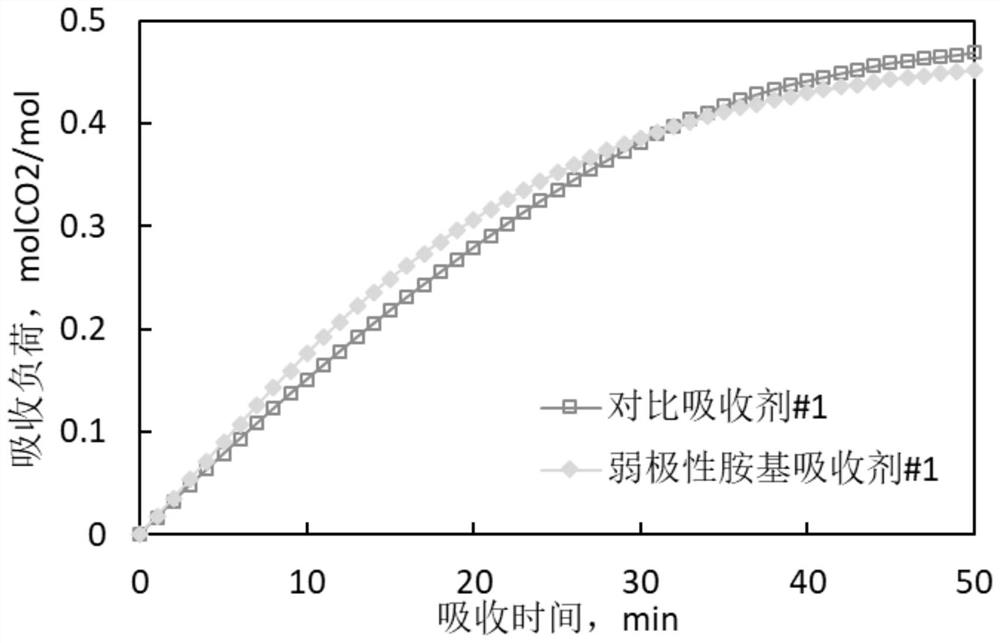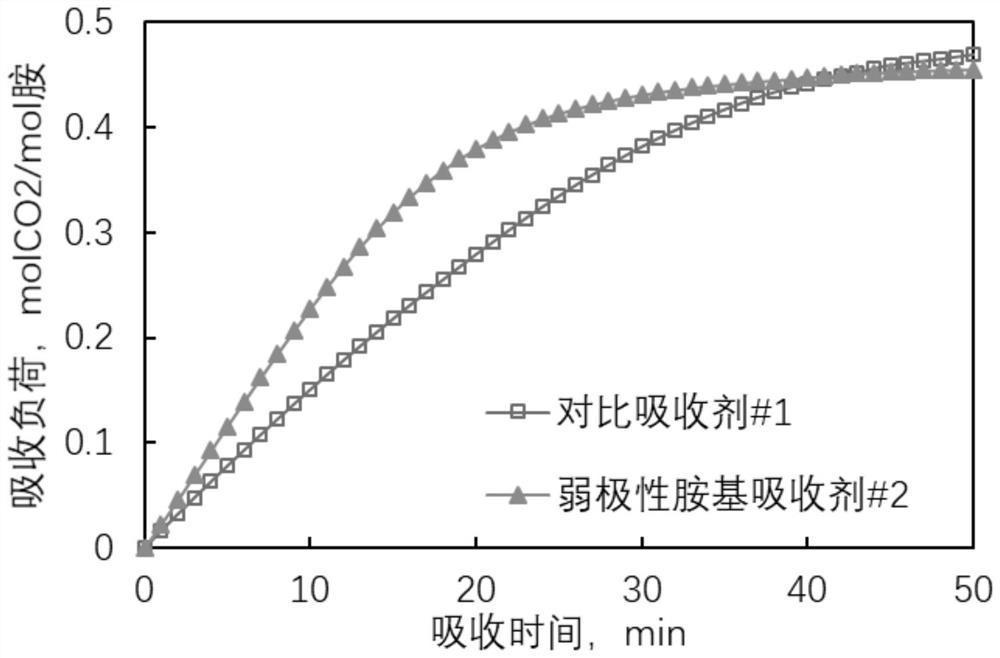Weak-polarity amino absorbent for capturing low-concentration flue gas CO2
A weakly polar solvent and weakly polar technology, applied to the separation of dispersed particles, chemical instruments and methods, separation methods, etc., can solve the problem of increased system investment and operating costs, high absorbent circulation flow, and reduced energy consumption in the regeneration process, etc. problems, achieve the effect of small latent heat of water evaporation, high CO2 cycle capacity, and reduce regeneration energy consumption
- Summary
- Abstract
- Description
- Claims
- Application Information
AI Technical Summary
Problems solved by technology
Method used
Image
Examples
Embodiment 1
[0033] Configure weakly polar amine-based absorbent #1: Measure 38 grams of 2-methylaminoethanol, 47 grams of diethylene glycol dimethyl ether, and 15 grams of deionized water, stir and mix evenly, keep warm in a water bath to 40°C, and set aside .
[0034] Configure comparative absorbent #1: Measure 30 grams of monoethanolamine and 70 grams of deionized water, stir and mix evenly, place in a water bath to keep warm at 40°C, and set aside.
[0035] CO 2 Absorption experiment: The prepared absorbent was added into a self-made bubbling absorption reactor, nitrogen (N 2 ) and CO 2 The mixed gas is fed into the absorption reactor, the total flow rate is 1L / min, the pressure is normal pressure, CO 2 The volume concentration is 12%, the temperature is controlled by a water bath at 40°C, and the absorption time is 50 minutes, during which the CO of the outlet gas is recorded in real time 2 concentration.
[0036] CO 2 Desorption experiment: Absorbed CO 2 The absorbent is trans...
Embodiment 2
[0039] Configure weakly polar amine-based absorbent #2: Measure 35 grams of 2-ethylaminoethanol, 42 grams of ethylene glycol butyl ether, 10 grams of N-methyldiethanolamine, and 13 grams of deionized water, stir and mix well, place in Keep warm in a water bath to 40°C and set aside.
[0040] CO measurement of weakly polar amine-based absorbent #2 2 Absorption rate, CO 2 Desorption rate, CO 2 The degree of desorption and the absorption-desorption cycle capacity are obtained as figure 2 Absorption load vs. time curves for weakly polar amine-based absorbent #2 are shown, and the results show that the average CO 2 Absorption rate increased by 35%, initial CO 2 69% faster desorption rate, average CO 2 110% faster desorption rate, CO 2 The degree of desorption is increased by 93%, the absorption-desorption cycle capacity is increased by 66%, and the estimated regeneration energy consumption is reduced by 45%.
Embodiment 3
[0042] Configure weakly polar amine-based absorbent #3: Measure 41 grams of 2-butylaminoethanol, 31 grams of 1,4-diazidebicyclooctane, 18 grams of 1-amino-2-methyl-2-propanol, 10 grams of deionized water, stirred and mixed evenly, placed in a water bath to keep warm to 40°C, and set aside.
[0043] CO measurement of weakly polar amine-based absorbent #3 2 Absorption rate, CO 2 Desorption rate, CO 2 The degree of desorption and the absorption-desorption cycle capacity are obtained as image 3 Absorbent load vs. time curves for weakly polar amine-based absorbent #3 are shown, and the results show that the average CO 2 Absorption rate increased by 23%, initial CO 2 41% faster desorption rate, average CO 2 65% faster desorption rate, CO 2 The degree of desorption is increased by 41%, the absorption-desorption cycle capacity is increased by 58%, and the estimated regeneration energy consumption is reduced by 37%.
PUM
 Login to View More
Login to View More Abstract
Description
Claims
Application Information
 Login to View More
Login to View More - R&D Engineer
- R&D Manager
- IP Professional
- Industry Leading Data Capabilities
- Powerful AI technology
- Patent DNA Extraction
Browse by: Latest US Patents, China's latest patents, Technical Efficacy Thesaurus, Application Domain, Technology Topic, Popular Technical Reports.
© 2024 PatSnap. All rights reserved.Legal|Privacy policy|Modern Slavery Act Transparency Statement|Sitemap|About US| Contact US: help@patsnap.com










